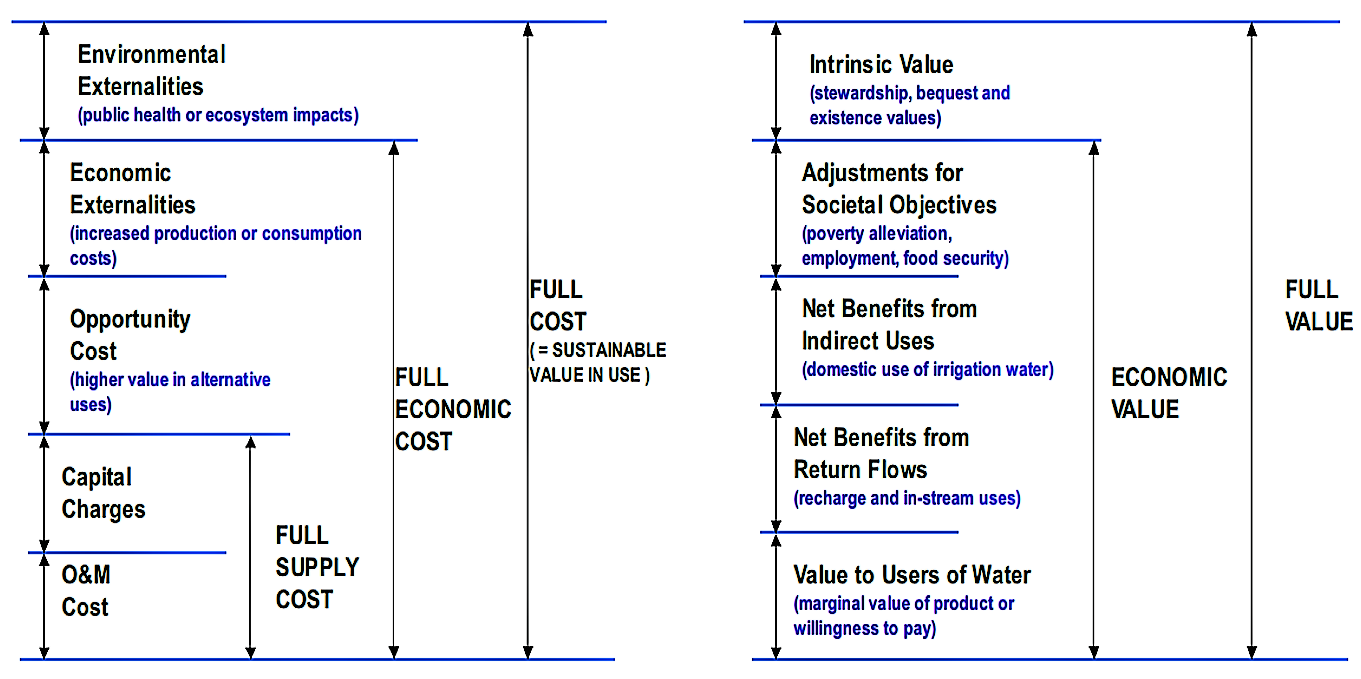المُلخص التنفيذي
Tradable water rights are one of several market-based instruments used in water management and pollution control. In economic theory, they are increasingly seen as an efficient instrument for implementing environmental and natural resources management policies on national or supranational level, even though they are among the most challenging means in terms of both their design and implementation. As their main advantage, tradable rights set an overall quantitative goal and, at the same time, provide the flexibility required to achieve the best individual allocation of rights through decentralised transfers guided by market demand (OECD 2002).
Introduction
Tradable water rights can function as a possible market-based solution for existing disagreement concerning the availability and allocation of water (see PDF1 and PDF2) (KRAEMER et al. 2004). Under this approach, a responsible authority establishes an overall level of allowable pollution or abstraction for a certain amount of time and allocates this in form of permits among its sources of consumption or pollution. Enterprises that keep their emissions/usage below the allotted level may sell or lease their surplus permits to firms that require additional permits or use them to offset excess emissions in other parts of their facilities (STAVINS & WHITEHEAD 1992).
The Economic Model
Economic instruments concerning scarce resources are based on the assumption that environmental degradation (such as soil degradation) and resource depletion occur because a substantial part of the costs of economic activities is not being paid by the actors responsible but by the general public in the form of environmental damage, security (see also water conflicts), health risks, or long-term climatic risks. The most frequently used economic measures to improve this situation are the establishment of tradable rights, the implementation of water charges, or subsidies.

In a system of tradable rights, a market for the trading of resource use permits (such as the permit to use or pollute a certain amount of water) needs to be created. Whoever wants to use environmental resources has to buy the respective permit on these markets (KAUFMANN-HAYOZ et al. 2001). The rationale behind water allocation through tradable rights is that in a perfectly competitive market, permits will flow towards their highest value user: Permit holders that gain a lower benefit from using their permits (for example due to higher costs) have an incentive to trade with someone who values them more. Such a sale of permissions will therefore result in a situation of mutual benefit (KRAEMER et al. 2003).
Types of Water Rights
Water rights can be distributed to water abstraction, the consumption of water-based resources (e.g. fish), and water pollution. The rights can further be differentiated according to their time scale (permanent, temporary or one-off rights) (KRAEMER et al. 2003).
Tradable water pollution rights face a much higher degree of complexity than water abstraction rights. Knowing the effect of a set level is difficult to assess, because there is a large array of different pollutants (see also pathogens and contaminants, which can in combination also potentiate each other (KRAEMER et al. 2003). It is therefore especially important to consider the interests of stakeholders when implementing such pollution rights.
Secondly, water pollution is directly tied to both location and time of the year. Therefore, marketable permits may not always be as effective for controlling water pollution as other economic instruments (see also water charges and subsidies) (HELMER & HESPANHOL 1997).
Implementation
For a successful implementation of tradable water rights, three system requirements need to be fulfilled (KRAEMER et al. 2003):
- Secure property rights
- Water rights must be enforceable (see also strengthening enforcement bodies)
- Efficient administrative system to ensure market operation
If these prerequisites are not adequately met, monopoly market power, the presence of high transaction costs as well as insufficient monitoring and enforcement are possible negative outcomes.
Several further requirements have to be taken into consideration and limit the applicability of tradable water abstraction and pollution rights (adapted from ANDERSON 2002):
- Legal and regulatory framework (see also institutional framework and legal framework): Delineation of roles and responsibilities of the different parties.
- Overall cap on emissions and sources to include.
- Determination of emission quotas (when applying tradable water pollution rights).
- Timing and spatial issues.
- Mechanisms for measuring emissions.
- Tracking and enforcement requirements.
Due to this list of necessities, successfully implementing tradable water rights is considerably more challenging than water charges.
A quantitative limit for tradable permits can be introduced either as a maximum ceiling for “cap and trade” schemes, or as a minimum performance commitment for “baseline and credit” schemes (JOHNSTONE & TIETENBERG 2004). These targets can be either in absolute or in relative terms. Many alternative baselines are possible for credits, allowing room for inventiveness on the part of policy-makers in designing a tradable permit scheme (OECD 2002).
The implementation and enforcement of water rights can be troublesome in many respects. Often, implementation places heavy demands on technical competence as well as on the amount of available human resources and financial assets to control the compliance with imposed restrictions (KAUFMANN-HAYOZ et al. 2001). In practice, the granting of exceptions recurrently compromises the implementation. In some cases, moreover, legal prescriptions (see also restrictions and standards) directed toward barely accessible target groups (such as “water consumers”) are very difficult to enforce, because control is almost impossible. Therefore the motive to avoid sanctions disappears (e.g. for illegal wastewater disposal). Tradable water rights could become increasingly relevant as the concept of virtual water is given more importance.
Incentive-Based Policies for Environmental Management in Developing Countries
Water Pollution Control - A Guide to the Use of Water Quality Management Principles
This document is rather old, but its publication was a milestone as it demonstrates WSSCCs capacity to bring together water and sanitation professionals from industrialised and developing countries to formulate practical guidance on a key issue of the day. Mainly regulatory, financial and technical aspects are discussed and illustrated with an extensive collection of case studies from the developing world.
HELMER, R. ; HESPANHOL, I. (1997): Water Pollution Control - A Guide to the Use of Water Quality Management Principles. World Health Organization (WHO), Water Supply and Sanitation Collaborative Council (WSSCC) and United Nations Environment Programme (UNEP) URL [Accessed: 21.04.2010]ExPost Evaluation of Tradable Permits: Methodological Issues and Literature Review
A Typology of Tools for Building Sustainability Strategies
Since the 1980s, the Swiss federal government has actively pursued a policy to reduce the emission of pollutants from heating systems. The program bases upon three measures, which are regulatory in nature: emission thresholds, systems inspections with permits and heating controls.
KAUFMANN-HAYOZ, R. BAETTIG, C. BRUPPACHER, S. DEFILA, R. DI GIULIO, A. FLURY-KLEUBER, P. FRIEDERICH, U. GARBELY, M. JAEGGI, C. JEGEN, M. MOSLER, H.J. MUELLER, A. NORTH, N. ULLI-BEER, S. WICHTERMANN, J. (2001): A Typology of Tools for Building Sustainability Strategies. المُدخلات: KAUFMANN-HAYOZ, R. ; GUTSCHER, H. (2001): Changing Things – Moving People. Strategies for Promoting Sustainable Development at the Local Level. Basel: 33-108. URL [Accessed: 29.04.2019]Environment Network: Economic Instruments for Water Management
In this report, functions of and experiences with several economic instruments are documented. The paper follows the II Meeting of the Environment Network of the Regional Policy Dialogue in Washington, D.C., held on February 11 and 12 2003, where policy makers focused on the application of economic instruments for environmental management.
KRAEMER, R. CASTRO, Z. SEROA DA MOTTA, R. RUSSEL, C. (2003): Environment Network: Economic Instruments for Water Management. Experiences from Europe and Implications for Latin America and the Caribbean. (= (=Proceedings of the 2nd meeting of the Environment Network of the Regional Policy Dialogue, 11th to 12th February 2003) ). Washington D.C.: Inter-American Development Bank, Regional Policy Dialogue Series URL [Accessed: 18.06.2012]The Role of Tradable Permits in Water Pollution Control
Implementing Domestic Tradable Permits. Recent Developments and Future Challenges
Water as an Economic Good and Demand Management. Paradigms with Pitfalls. International Water Resources Association
This paper argues that water pricing should primarily serve the purpose of financial sustainability through cost recovery. Instead of economic pricing, there is a need for defining a reasonable price, which provides full cost recovery but which safeguards ecological requirements and access to safe water for the poor.
SAVENIJE, H. ; ZAAG, P. van der (2002): Water as an Economic Good and Demand Management. Paradigms with Pitfalls. International Water Resources Association. المُدخلات: Water International: Volume 27 , 98–104. URL [Accessed: 22.04.2019]Pollution Charges for Environmental Protection
Economic Instruments for Water Demand Management in an Integrated Water Resources Management Framework
This report is a synthesis paper based in part on an Experts Symposium held in June 2004. It reviews the use of economic instruments for water demand management, such as pricing and markets. Available in English and French.
PRI (2005): Economic Instruments for Water Demand Management in an Integrated Water Resources Management Framework. (= (=Synthesis Report based in part on an Experts Symposium by the Policy Research Initiative, 14th to 15th June 2004) ). Ottawa: Policy Research Initiative (PRI) URL [Accessed: 19.06.2012]Reforming Water Allocation Policy through Markets in Tradable Water Rights
This paper extensively focuses on necessary policies for a successful implementation of tradable water rights. Lessons are drawn from case studies from Chile, Mexico, and California.
ROSEGRANT, W. GAZMURI, R. (1994): Reforming Water Allocation Policy through Markets in Tradable Water Rights. Lessons from Chile, Mexico, and California. Washington D.C.: International Food Policy Research Institute URL [Accessed: 15.06.2012]Water Quality Trading Programs
A worldwide look at the state of water quality trading: Based on a survey of stakeholders, an overview of the key factors necessary for a successful program implementation is compiled, resulting in recommendations for the development of water quality trading programs.
SELMAN, M. GREENHALGH, S. BRANOSKY, E. JONES, C. GUILING, J. (2009): Water Quality Trading Programs. An International Overview. (= WRI Issue Brief , 1 ). Washington D.C.: World Resources Institute (WRI) URL [Accessed: 13.06.2012]Tradable Property Rights to Water
Establishing Tradable Water Rights
Comparison of two cases where tradable water rights were implemented in rural South Africa. In one case, the market for water rights bloomed, whereas in the other case transactions did not follow due to a lack of sellers
ARMITAGE, R. ; NIEUWOUDT, W. ; BACKEBERG, G. (1999): Establishing Tradable Water Rights. Case Studies of two Irrigation Districts in South Africa. المُدخلات: Water SA: Volume 25 , 301-310. URL [Accessed: 14.06.2019]Marketing Water, Marketing Reform
Chile is known as the world’s leading example of the free-market approach to water law and economics. This publication summarises the Chilean experience, showing benefits and problems.
BAUER, C. (2003): Marketing Water, Marketing Reform. Lessons from the Chilean Experience. Washington D.C.: Resources for the Future (RFF) URL [Accessed: 14.06.2019]Economics in Sustainable Water Management
Training guide, which delivers an overview on possible economic and financial tools for water management. The application ranges from water resources, through water supply and sanitation. Further training material as well as supporting PowerPoint’s are available on the website (in English, French, Spanish, and Portuguese).
CAP-NET (2008): Economics in Sustainable Water Management. Training Manual and Facilitator's Guide. URL [Accessed: 22.04.2019]Tradable Permits for Water Management
A presentation giving an overview on the typologies of economic measures in water management with a focus on the role of tradable permits.
KRAEMER, R. (2003): Tradable Permits for Water Management. Conceptual Framework. Berlin: Ecologic, Institute for International and European Environmental Policy. [Accessed: 18.06.2012] PDFEconomic Instruments - Using value and prices for efficiency and equity
What are water markets and tradable permits and how can they be achieved? This page gives a short overview related to these questions. It further contains a list of documented related cases.
Water Markets Dashboard
Website from the Australian Government concerning water rights in Australia. In Australia, an array of water rights is applied, including tradable water rights.


